Practice Free AZ-305 Exam Online Questions
Your company has 50 business units across the globe. The business units operate from 08:00 AM to 06:00 PM from Monday to Friday in their local time zone. Transactions are only processed during business hours.
You have an Azure subscription.
You plan to deploy an app named App1 that will manage the transactions for the business units.
App1 will use a separate Azure SQL database for each business unit.
You need to recommend an Azure SQL Database configuration for App1.
The solution must meet the following requirements:
• Support Azure Hybrid Benefit licensing.
• Minimize costs.
What should you recommend?
- A . a vCore purchasing model and multiple single database instances
- B . a DTU purchasing model and multiple single database instances
- C . a vCore purchasing model and multiple database instances in an elastic pool
- D . a DTU purchasing model and multiple database instances in an elastic pool
HOTSPOT
You are designing an Azure web app.
You plan to deploy the web app to the North Europe Azure region and the West Europe Azure region.
You need to recommend a solution for the web app.
The solution must meet the following requirements:
✑ Users must always access the web app from the North Europe region, unless the region fails.
✑ The web app must be available to users if an Azure region is unavailable.
✑ Deployment costs must be minimized.
What should you include in the recommendation? To answer, select the appropriate options in the answer area. NOTE: Each correct selection is worth one point.
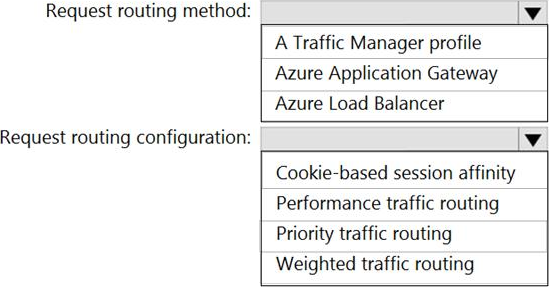
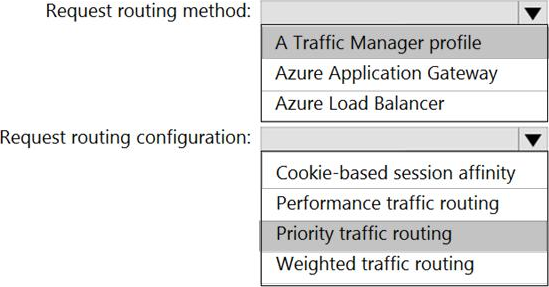
Explanation:
https://docs.microsoft.com/en-us/azure/traffic-manager/traffic-manager-routing-methods#priority-traffic-routing-method
You have an Azure subscription.
You need to recommend a solution to provide developers with the ability to provision Azure virtual machines.
The solution must meet the following requirements:
• Only allow the creation of the virtual machines in specific regions.
• Only allow the creation of specific sizes of virtual machines.
What should you include in the recommendation?
- A . Conditional Access policies
- B . role-based access control (RBAC)
- C . Azure Resource Manager (ARM) templates
- D . Azure Policy
D
Explanation:
https://docs.microsoft.com/en-us/azure/governance/policy/tutorials/create-and-manage
https://docs.microsoft.com/en-us/azure/cloud-adoption-framework/manage/azure-server-management/common-policies#restrict-vm-size
You plan to deploy an Azure App Service web app that will have multiple instances across multiple Azure regions.
You need to recommend a load balancing service for the planned deployment.
The solution must meet the following requirements:
✑ Maintain access to the app in the event of a regional outage.
✑ Support Azure Web Application Firewall (WAF).
✑ Support cookie-based affinity.
✑ Support URL routing.
What should you include in the recommendation?
- A . Azure Front Door
- B . Azure Load Balancer
- C . Azure Traffic Manager
- D . Azure Application Gateway
A
Explanation:
Azure Traffic Manager performs the global load balancing of web traffic across Azure regions, which have a regional load balancer based on Azure Application Gateway. This combination gets you the benefits of Traffic Manager many routing rules and Application Gateway’s capabilities such as WAF, TLS termination, path-based routing, cookie-based session affinity among others.
Reference: https://docs.microsoft.com/en-us/azure/application-gateway/features
You have an on-premises application named App1 that uses an Oracle database.
You plan to use Azure Databricks to transform and load data from App1 to an Azure Synapse Analytics instance.
You need to ensure that the App1 data is available to Databricks.
Which two Azure services should you include in the solution? Each correct answer presents part of the solution. NOTE: Each correct selection is worth one point.
- A . Azure Data Box Edge
- B . Azure Data Lake Storage
- C . Azure Data Factory
- D . Azure Data Box Gateway
- E . Azure Import/Export service
HOTSPOT
You have several Azure App Service web apps that use Azure Key Vault to store data encryption keys.
Several departments have the following requests to support the web app:

Which service should you recommend for each department’s request? To answer, configure the appropriate options in the answer area. NOTE: Each correct selection is worth one point.
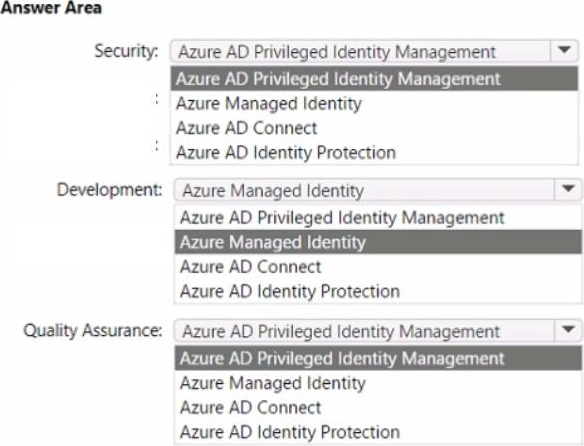
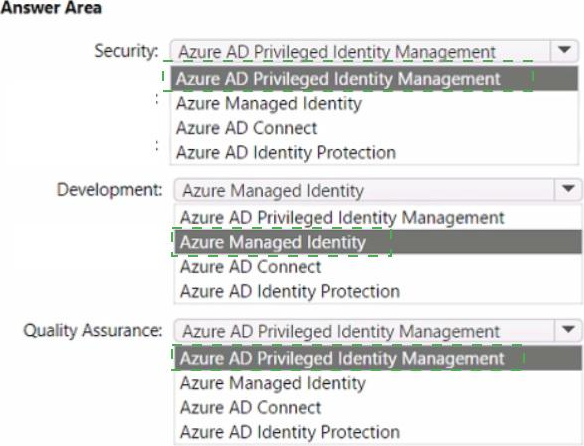
Your company plans to deploy various Azure App Service instances that will use Azure SQL databases.
The App Service instances will be deployed at the same time as the Azure SQL databases.
The company has a regulatory requirement to deploy the App Service instances only to specific Azure regions. The resources for the App Service instances must reside in the same region.
You need to recommend a solution to meet the regulatory requirement.
Solution: You recommend using the Regulatory compliance dashboard in Microsoft Defender for Cloud.
Does this meet the goal?
- A . Yes
- B . No
You have an Azure subscription that contains a Windows Virtual Desktop tenant.
You need to recommend a solution to meet the following requirements:
✑ Start and stop Windows Virtual Desktop session hosts based on business hours.
✑ Scale out Windows Virtual Desktop session hosts when required.
✑ Minimize compute costs.
What should you include in the recommendation?
- A . Microsoft Intune
- B . a Windows Virtual Desktop automation task
- C . Azure Automation
- D . Azure Service Health
C
Explanation:
Reference:
https://www.ciraltos.com/automatically-start-and-stop-wvd-vms-with-azure-automation/
https://wvdlogix.net/windows-virtual-desktop-host-pool-automation-2
https://getnerdio.com/academy/how-to-optimize-windows-virtual-desktop-wvd-azure-costs-with-event-based-autoscaling-and-azure-vm-scale-sets/
You have 100 Microsoft SQL Server integration Services (SSIS) packages that are configured to use 10 on-premises SQL Server databases as their destinations.
You plan to migrate the 10 on-premises databases to Azure SQL Database
You need to recommend a solution to host the SSlS packages in Azure. The solution must ensure that the packages can target the SQL Database instances as their destinations.
What should you include in the recommendation?
- A . SQL Server Migration Assistant (SSMA)
- B . Azure Data Catalog
- C . Data Migration Assistant
- D . Azure Data Factory
D
Explanation:
https://docs.microsoft.com/bs-cyrl-ba/azure/sql-database/sql-database-managed-instance-migrate
Quote from that page "Azure SQL Database and SQL Server databases in an Azure Virtual Machine.
DMS is the recommended method of migration for your enterprise workloads.
If you use SQL Server Integration Services (SSIS) on your SQL Server on premises, DMS does not yet support migrating SSIS catalog (SSISDB) that stores SSIS packages, but you can provision Azure-SSIS Integration Runtime (IR) in Azure Data Factory (ADF) that will create a new SSISDB in a managed instance and then you can redeploy your packages to it, see Create Azure-SSIS IR in ADF.
To learn more about this scenario and configuration steps for DMS, see Migrate your on-premises database to managed instance using DMS."
https://docs.microsoft.com/en-us/azure/data-factory/how-to-migrate-ssis-job-ssms
HOTSPOT
You need to design an Azure policy that will implement the following functionality:
• For new resources, assign tags and values that match the tags and values of the resource group to which the resources are deployed.
• For existing resources, identify whether the tags and values match the tags and values of the resource group that contains the resources.
• For any non-compliant resources, trigger auto-generated remediation tasks to create missing tags and values.
The solution must use the principle of least privilege.
What should you include in the design? To answer, select the appropriate options in the answer area. NOTE: Each correct selection is worth one point.
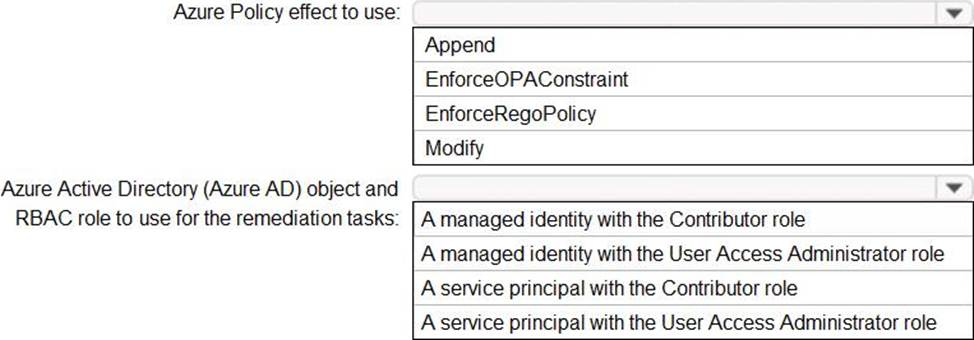
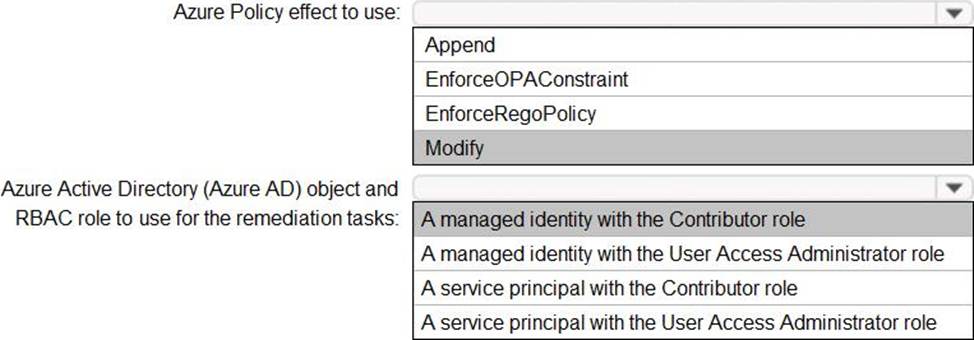
Explanation:
Box 1: Modify
Modify is used to add, update, or remove properties or tags on a resource during creation or update. A common example is updating tags on resources such as costCenter. Existing non-compliant resources can be remediated with a remediation task. A single Modify rule can have any number of operations.
Box 2: A managed identity with the Contributor role Managed identity
How remediation security works: When Azure Policy runs the template in the deployIfNotExists policy definition, it does so using a managed identity. Azure Policy creates a managed identity for each assignment, but must have details about what roles to grant the managed identity.
Contributor role
The Contributor role grants the required access to apply tags to any entity.
Reference:
https://docs.microsoft.com/en-us/azure/governance/policy/concepts/effects
https://docs.microsoft.com/en-us/azure/governance/policy/how-to/remediate-resources
https://docs.microsoft.com/en-us/azure/azure-resource-manager/management/tag-resources
https://docs.microsoft.com/en-us/azure/governance/policy/concepts/effects#modify
